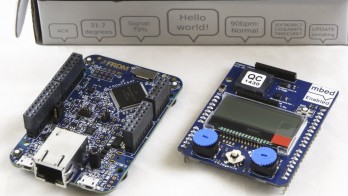IBM and ARM have announced a joint project to create embedded products and integrate them with the Internet of Things. This is not the first time the two companies have collaborated — last year they also established a partnership with ARM's mbed platform — but this new system is more powerful, more flexible, and integrated with IBM's BlueMix cloud platform.
The new starter kit is officially called the IoT Starter Kit-Ethernet Edition. It is based on the Freescale K64F platform, which uses a Cortex-M4 processor with integrated floating-point unit and DSP. The chip's clock frequency is 120MHz, with 256KB of RAM and 1MB of flash memory. This is a major upgrade to last year's model, which uses a 96MHz Cortex-M3 processor, only 32KB of RAM and 512KB of flash memory. It can also upgrade the SPI and L2C buses and the number of peripherals included in them. It also supports on-board Ethernet, hence the name "Ethernet Edition".
The platform is designed to enable small companies to perform rapid prototyping and equipment testing. Cortex-M4 is the fastest embedded processor design currently released by ARM (the high-end Cortex-M7 was released last September but has not yet been shipped). Its DSP and FPU support provide the core with the additional flexibility that older Cortex-M3 lacks, and it should fit multiple types of dedicated IoT concepts. The theoretical advantage of IBM related products is the big data back end-using a dedicated ARM processor to collect information in advance, and then using IBM's complex management and cloud platform service tools to understand the information in real time.
ARM's New Development Platform, Freescale FRDM1
A major goal of the ARM mbed project is to make prototyping and device functions as easy as possible. The kit will be provided with ARM's mbed OS and will reportedly guide enthusiasts through the process of manufacturing basic equipment and connecting to IBM's BlueMix cloud service. An example of the initial interface is shown below:
The web interface and instant feedback on device features are great, but whether these simple handheld tutorials will translate into products that are easy to program is still an open question. Embedded systems are not easy to program. As we all know, 1MB of on-board flash memory and 256KB of RAM do not leave much room for code expansion. IBM will provide a real-time data visualization tool that is currently accessible from the company's Starter Kit website. Some basic code examples are also provided.
So far, the entire IoT seems more like a solution to a problem than a solution that users want to adopt at scale. However, most of the products we see are top-down development. Large companies develop around the basic concepts of "smart" devices. Smaller projects by companies such as PebbleandNest have achieved greater success, suggesting that greater access and more imagination may be exactly what the IoT needs to cause a stir.
